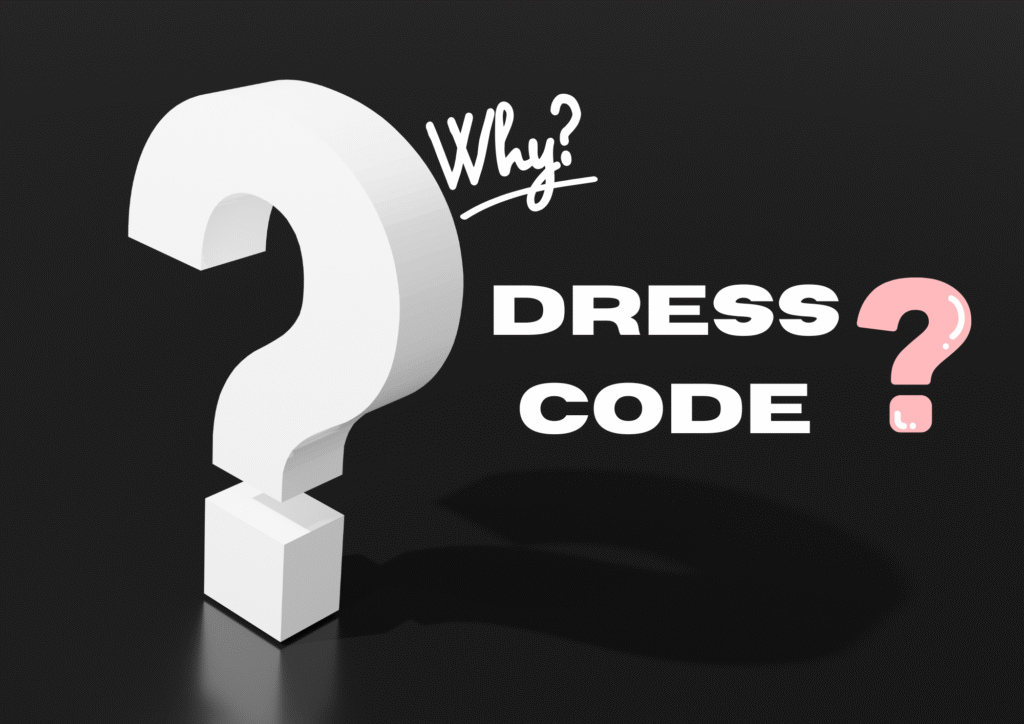Ask most people how they feel about dress codes, and you’ll probably get mixed answers. Some see them as helpful. Others see them as unnecessary or even outdated. But the truth is, a dress code is about more than just telling people what to wear. It plays a real role in how we function together at work, at school, and in everyday life.
Let’s take a closer look at why dress code is important, how they help, and why they’re still relevant in today’s world.

1. Sets the Tone in Professional Spaces
Imagine walking into a job interview and seeing the interviewer in pajamas. It might seem funny at first, but you’d probably question how seriously they take their role. That’s the power of clothing. What we wear says something before we even speak.
In the workplace, a dress code creates a standard for professionalism. Whether it’s formal, business casual, or uniform-based, it helps employees represent the company in a consistent and respectful way. It also shows clients and customers that the organization takes pride in what it does.
Not every office needs suits and ties. But every workplace does benefit from a shared understanding of what “appropriate” means.
2. Creates Focus and Discipline in Schools
For students, especially in school settings, dress codes help create a space where learning comes first. When everyone is dressed in a similar way, it becomes easier to focus on what matters instead of comparing brands, trends, or styles.
School uniforms, or even simple guidelines about clothing, help reduce distractions and peer pressure. They also teach students that certain environments call for a certain kind of presence. Over time, this helps build self-discipline and respect for structure.
It’s not about removing creativity. It’s about helping young people grow into spaces where effort and focus are valued.
3. Supports Fairness and Equality
Clothes can say a lot about who we are, but they can also reflect what we can afford. In many schools and workplaces, a dress code helps create a level playing field by reducing visible signs of income or status.
When everyone follows the same basic guidelines, people are less likely to be judged by their appearance. This helps shift attention toward attitude, behavior, and performance. In short, it gives everyone a fair chance to be seen for who they are, not just what they’re wearing.
4. Builds a Sense of Belonging
Whether you’re a student, a nurse, a retail worker, or a flight attendant, the way you dress can connect you to a larger group. That sense of unity matters. When people wear a uniform or follow a shared dress code, it can create pride in belonging to a team or organization.
This kind of visual consistency is also useful to others. Customers, clients, or guests can instantly recognize who to talk to or what someone’s role is. It adds clarity, trust, and professionalism to the environment.
5. Can Be About Safety
In many industries, dress code is not just about image. It’s about safety. For example, construction workers wear helmets and reflective vests for protection. Healthcare workers wear scrubs to maintain hygiene. Even chefs have specific attire designed for both comfort and safety in the kitchen.
In these situations, dress code is essential. It helps protect people, keeps environments clean, and ensures everyone follows the same standards for well-being.
6. Respects Cultural and Social Context
Every space has its own expectations. What’s appropriate at a beach wedding may not work in a boardroom. A dress code helps people understand those expectations and show up in a way that’s respectful to the occasion or the group.
This is especially important in diverse environments where people come from different cultural or religious backgrounds. A thoughtful dress code helps everyone navigate those differences with respect and care.
7. Removes the Guesswork
Most of us have experienced the awkward moment of being overdressed or underdressed for an event. It can throw off your confidence and make it harder to enjoy yourself. Dress codes help avoid that problem.
When event organizers or companies share a dress code, they’re not being controlling. They’re helping everyone arrive on the same page, so no one feels out of place. It keeps things simple, and it helps people feel more at ease.
8. Can Influence How We Feel
Believe it or not, what you wear can change how you think and act. Research shows that dressing up — even just a little — can boost your confidence, focus, and motivation. It’s called enclothed cognition.
That’s part of why dress codes matter. When you dress with intention, you often carry yourself with more purpose. A clear dress code helps set that intention, whether you’re preparing for a presentation, a classroom, or a formal event.
So, Why dress code is important?
A dress code is not about control. It’s about creating a shared understanding of how to show up for yourself and for others. It brings structure to spaces where people work, learn, and gather. It helps maintain fairness, respect, and professionalism without taking away individuality.
Of course, dress codes should evolve with the times. They should be inclusive, flexible, and sensitive to different needs and backgrounds. But the basic idea remains the same. How we dress impacts how we’re seen, how we feel, and how we connect with others.
So whether you’re following a policy at work, picking out clothes for school, or choosing what to wear to a special event, remember this: a dress code is not just about clothes. It’s about communication, identity, and respect.
Tell us about the next topic for blog here and connect to us on social

